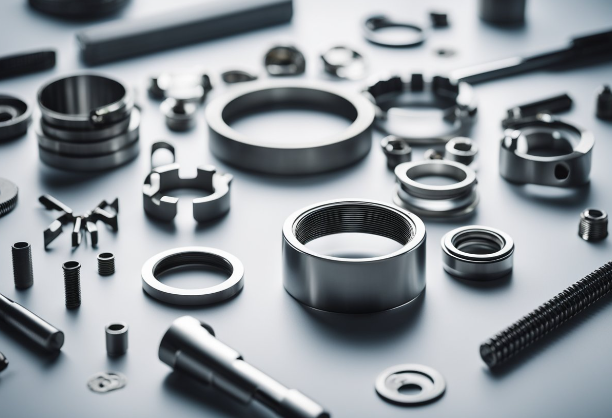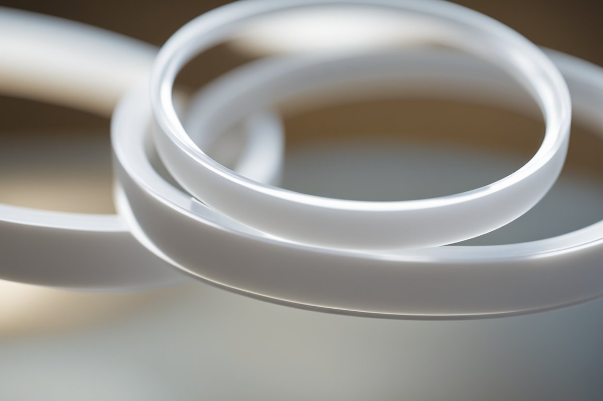PTFE Glyd Ring: A Comprehensive Guide
If you work in the engineering or manufacturing industries, chances are you've heard of PTFE Glyd Rings. These rings are a type of sealing solution that are used in hydraulic and pneumatic systems to prevent leaks and ensure smooth operation. PTFE Glyd Rings are highly valued for their durability, chemical resistance, and low friction coefficient, which makes them ideal for use in high-pressure and high-speed applications.
PTFE Glyd Rings are made from a combination of PTFE and an elastomer energizer, which creates a one-piece bonded construction that is highly effective at preventing leaks. The PTFE material is chemically inert and can withstand a wide range of temperatures, pressures, and corrosive chemicals, making it ideal for use in harsh environments. The elastomer energizer provides the necessary force to keep the PTFE seal in place and prevent it from spinning with the shaft. This design ensures that the seal remains effective over a long period of time, even in high-speed and high-pressure applications.
Overall, PTFE Glyd Rings are a highly effective sealing solution that can help to improve the efficiency and reliability of your hydraulic or pneumatic system. Whether you are looking to prevent leaks, reduce friction, or improve the overall performance of your system, PTFE Glyd Rings are an excellent choice that can deliver long-lasting results.
PTFE Glyd Ring Overview

Definition and Composition
A PTFE Glyd Ring is a type of seal that is used to prevent leakage of fluids or gases in high-pressure applications. It is made of a PTFE-based sealing ring that is bonded to an elastomer energizer. The energizer provides the necessary force to keep the sealing ring in contact with the surface it is sealing against. The PTFE material provides excellent chemical resistance and low friction, making it ideal for use in harsh environments.
Mechanical Properties
PTFE Glyd Rings have several mechanical properties that make them ideal for use in high-pressure applications. These properties include:
- Low friction: PTFE has a very low coefficient of friction, which means that it creates very little resistance when moving against another surface. This makes it ideal for use in applications where low friction is important.
- Chemical resistance: PTFE is highly resistant to a wide range of chemicals, including acids, bases, and solvents. This makes it ideal for use in applications where the seal is exposed to harsh chemicals.
- High temperature resistance: PTFE can withstand temperatures up to 260°C (500°F) without degrading. This makes it ideal for use in applications where the seal is exposed to high temperatures.
- Low compression set: PTFE Glyd Rings have a low compression set, which means that they maintain their shape and sealing properties even after prolonged use.
- High wear resistance: PTFE is highly resistant to wear, which means that PTFE Glyd Rings have a long service life.
In summary, PTFE Glyd Rings are an excellent choice for use in high-pressure applications where chemical resistance, low friction, and high temperature resistance are required.
Manufacturing Process

Raw Material Selection
The manufacturing process of PTFE Glyd Ring starts with the selection of high-quality raw materials. PTFE resin is the primary raw material used in the production of Glyd Ring. The resin is carefully selected based on its purity, particle size, and molecular weight. This ensures that the final product has high strength, durability, and chemical resistance.
Molding and Curing
Once the raw material is selected, the next step is molding. The molding process is carried out in a controlled environment to ensure that the final product meets the required specifications. The PTFE resin is compressed into the required shape and size using a hydraulic press. The molded product is then cured at a specific temperature and pressure to ensure that it retains its shape and properties.
Quality Control
Quality control is an essential part of the manufacturing process. The Glyd Ring undergoes rigorous testing to ensure that it meets the required specifications. The quality control process includes visual inspection, dimensional measurement, and functional testing. The product is checked for any defects or irregularities, and corrective actions are taken if necessary.
In conclusion, the manufacturing process of PTFE Glyd Ring involves careful selection of raw materials, molding, curing, and quality control. The final product is a high-quality, durable, and reliable seal that can be used in a wide range of applications.
Applications
Hydraulic Systems
PTFE Glyd Rings are widely used in hydraulic systems for their superior sealing performance and durability. These rings can withstand high pressure and temperature, making them ideal for use in hydraulic cylinders, pumps, and valves. They can handle both dynamic and static applications, making them versatile for various hydraulic system components.
PTFE Glyd Rings are preferred over traditional seals due to their low coefficient of friction, which reduces wear and tear on the sealing surface. This property also helps to reduce energy consumption, making hydraulic systems more efficient. PTFE Glyd Rings are also resistant to most chemicals and can withstand harsh operating conditions, making them suitable for use in different hydraulic systems.
Pneumatic Systems
PTFE Glyd Rings are also used in pneumatic systems for their excellent sealing properties. They can handle high-pressure applications and can be used in both dynamic and static applications. Pneumatic systems that use PTFE Glyd Rings are more efficient and have a longer service life.
PTFE Glyd Rings can withstand a wide range of temperatures and are resistant to most chemicals, making them ideal for use in various pneumatic system components. They also have a low coefficient of friction, which reduces wear and tear on the sealing surface, resulting in a longer service life.
In summary, PTFE Glyd Rings are versatile seals that can be used in both hydraulic and pneumatic systems. They provide superior sealing performance, durability, and energy efficiency, making them the preferred choice for many applications.
Installation Guidelines
Installing a PTFE Glyd Ring is a simple process that requires attention to detail and patience. Here are some guidelines to ensure a proper installation:
Pre-Installation
Before installing the PTFE Glyd Ring, make sure that the installation area is clean and free from any debris or contaminants. This will prevent damage to the seal and ensure a proper fit. The shaft or rod that the seal will be installed on should also be free from any nicks, scratches, or other damage that could cause leakage.
Installation
To install the PTFE Glyd Ring, follow these steps:
- Lubricate the seal with a compatible lubricant. This will help the seal slide into place without damaging it.
- Gently slide the seal over the shaft or rod until it is in the desired position.
- Use a seal installation tool to press the seal into place. Be sure to apply even pressure to avoid damaging the seal.
- Check the seal to ensure that it is properly seated and in the correct position.
Post-Installation
After installing the PTFE Glyd Ring, it is important to check for any leaks or damage. If there are any leaks, the seal may not be properly installed or there may be damage to the shaft or rod. In this case, the seal should be removed and inspected for damage. If there is damage to the seal, it should be replaced before reinstallation.
In conclusion, proper installation of a PTFE Glyd Ring is essential for preventing leaks and ensuring a long service life. By following these guidelines, you can ensure a proper installation and avoid costly repairs in the future.
Maintenance and Troubleshooting
Routine Inspection
To ensure the optimal performance of your PTFE Glyd Ring, it is essential to conduct routine inspections. You should inspect the seal for any signs of damage, wear, or deformation. If you notice any of these issues, you should replace the seal immediately. You should also check the seal's installation to ensure that it is properly seated in the groove. If the seal is not correctly installed, it can cause premature failure.
Common Issues and Solutions
Despite the PTFE Glyd Ring's durability and long lifespan, it can still experience issues. Here are some common problems and their solutions:
- Leaking: If you notice that your seal is leaking, the first step is to identify where the leak is coming from. You may need to disassemble the equipment or machine and inspect all of the seals and gaskets carefully. If there is damage or wear visible in any of these parts, you should replace them immediately. If the seal is properly installed and in good condition, but still leaking, you may need to adjust the system's pressure or temperature.
- Excessive Wear: If your seal is experiencing excessive wear, it may be due to inadequate lubrication or contamination. Ensure that the seal is properly lubricated and that the lubricant is compatible with the seal material. If the seal is contaminated, you should clean it thoroughly before reinstallation.
- Installation Issues: If the seal is not properly installed, it can cause premature failure. Ensure that the seal is correctly seated in the groove and that the groove is clean and free of debris. If you are unsure about the installation process, refer to the manufacturer's guidelines or consult with a professional.
By conducting routine inspections and addressing any issues promptly, you can ensure that your PTFE Glyd Ring will continue to perform optimally for an extended period.
Frequently Asked Questions
What are the typical applications for Glyd rings in hydraulic systems?
Glyd rings are commonly used in hydraulic systems for dynamic sealing applications. They are suitable for use in reciprocating, oscillating, and rotary motion systems. Glyd rings are ideal for sealing hydraulic cylinders, pistons, rods, and shafts.
How does a Glyd ring compare to an O-ring in terms of performance?
Glyd rings offer superior performance compared to O-rings in many ways. They have a lower friction coefficient, which results in less wear and tear on the sealing surface. They also have a higher resistance to extrusion and a longer service life. Glyd rings are less prone to failure due to their ability to maintain a consistent seal under high pressure and temperature conditions.
Can Glyd rings be used in both dynamic and static sealing applications?
Glyd rings are primarily designed for dynamic sealing applications. However, they can be used in static sealing applications as well. It is important to note that Glyd rings are not recommended for applications where the seal is subjected to large radial movements.
What are the temperature and pressure limitations of Glyd rings?
Glyd rings are capable of operating in a wide range of temperatures, from -200°C to +260°C. They can also withstand high pressure environments, with a maximum operating pressure of 400 bar. It is important to choose the right Glyd ring material based on the specific temperature and pressure requirements of your application.
How do you properly install a Glyd ring to ensure optimal sealing?
Proper installation is essential to ensure optimal sealing performance of Glyd rings. The installation process involves cleaning the sealing surface, lubricating the Glyd ring, and ensuring that the ring is properly seated in the groove. It is important to follow the manufacturer's installation instructions to ensure a proper seal.
What maintenance and inspection routines are recommended for systems using Glyd rings?
Regular maintenance and inspection routines are essential for ensuring optimal performance of systems using Glyd rings. It is recommended to inspect the sealing surface and Glyd ring for wear and damage periodically. In addition, it is important to replace the Glyd ring periodically based on the manufacturer's recommended service interval.

